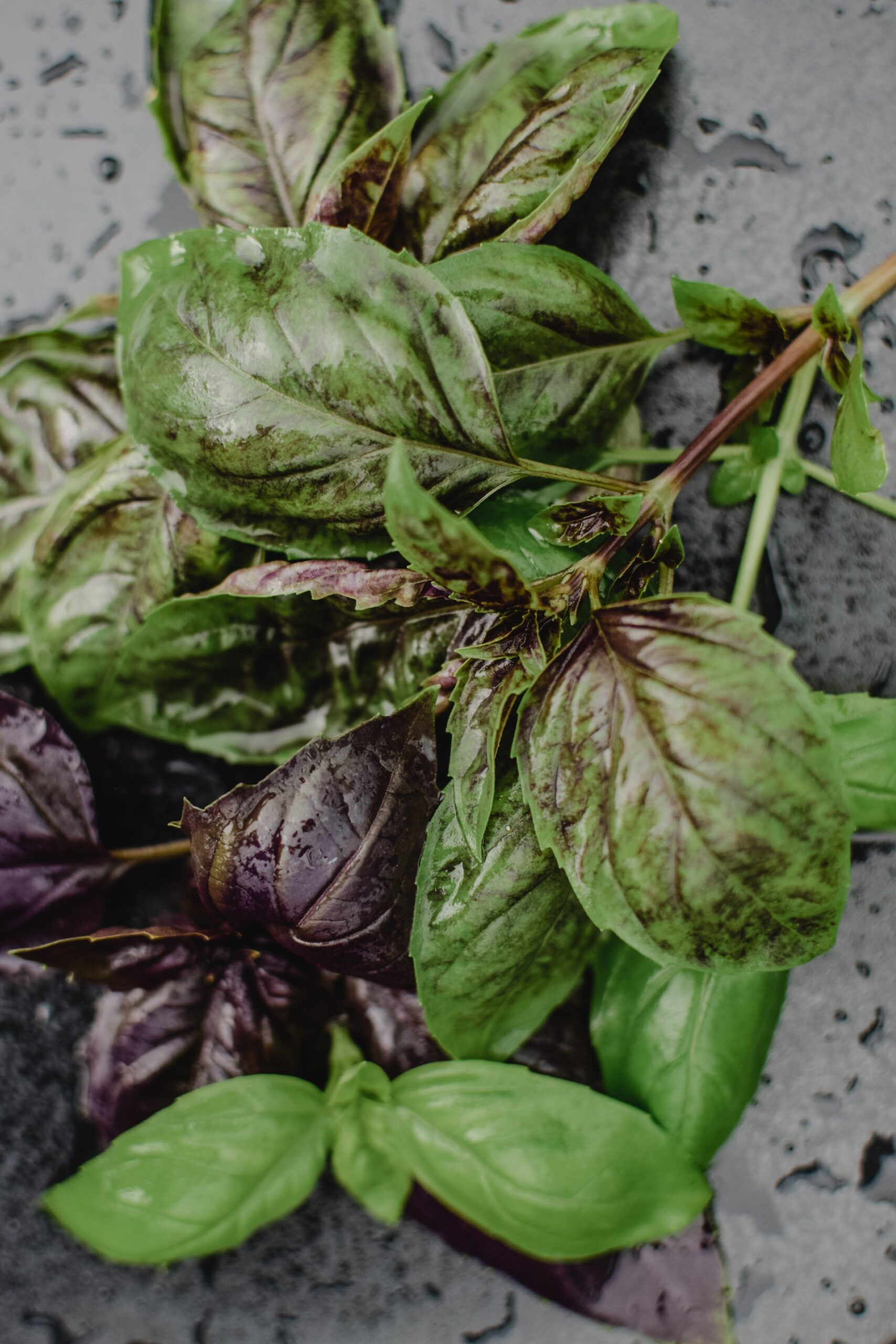
Basil is more than just one herb; it encompasses various types that differ in flavor, appearance, and culinary uses. Each type has its own unique characteristics that make it suitable for specific dishes or flavor combinations.
One popular variety is Genovese basil, which hails from Italy and is often referred to as “true” or “sweet” basil. It features large leaves with a slightly sweet yet peppery taste that pairs perfectly with tomatoes and mozzarella in classic Caprese salads or homemade pesto sauce.
If you’re looking to add a citrusy twist to your dishes, lemon basil is an excellent choice. As the name suggests, it has a distinct lemony flavor that adds brightness to salads, seafood dishes, and even desserts.
Thai basil is another well-known variety that is commonly used in Southeast Asian cuisine. It has a strong anise-like flavor with hints of licorice and mint. Thai basil is a key ingredient in dishes like Thai green curry and stir-fried noodles.
Other notable types of basil include cinnamon basil, which has a warm and spicy aroma reminiscent of cinnamon; holy basil, which is revered for its medicinal properties in Ayurvedic medicine; and purple basil, which boasts striking dark purple leaves that add visual appeal to any dish.
Exploring the different types of basil allows you to experiment with new flavors and expand your culinary repertoire. Whether you stick with the classics or venture into more exotic varieties, there’s no shortage of options when it comes to this versatile herb.

Choosing the Perfect Basil Variety for Your Needs
With so many different types of basil available, choosing the perfect variety for your needs can seem overwhelming. However, by considering a few key factors, you can narrow down your options and find the ideal basil variety for your garden or culinary endeavors.
Taste preference plays a significant role in selecting the right basil variety. If you enjoy traditional Italian flavors, Genovese or Italian sweet basil is an excellent choice. Its mild yet slightly peppery taste complements pasta dishes, pizzas, and tomato-based sauces perfectly.
If you’re looking for something more unique or adventurous, consider trying Thai basil or lemon basil. These varieties offer distinct flavors that can elevate both savory and sweet dishes.
Another important consideration is the intended use of the basil. Some varieties are better suited for fresh consumption, while others are more suitable for cooking or preserving. For example, Genovese basil is often used fresh in salads or as a garnish, while Thai basil is commonly used in stir-fries and curries.
Lastly, take into account the growing conditions in your area. Some basil varieties are more heat-tolerant and thrive in warmer climates, while others prefer cooler temperatures. By selecting a variety that is well-suited to your climate, you can ensure successful growth and abundant harvests.
Preparing the Soil: Creating the Ideal Growing Environment
Before planting your basil seeds or seedlings, it’s essential to prepare the soil properly to create an ideal growing environment for your plants. Basil thrives in well-draining soil that is rich in organic matter.
Start by removing any weeds or debris from the area where you plan to grow your basil. This will prevent competition for nutrients and ensure that your plants have ample space to grow.
Next, loosen the soil using a garden fork or tiller. This helps improve drainage and allows air to reach the roots of your plants. If the soil is compacted, consider adding organic matter such as compost or well-rotted manure to improve its structure.
Incorporate the organic matter into the soil using a garden rake, ensuring that it is evenly distributed throughout. This will provide your basil plants with essential nutrients and promote healthy growth.
It’s also important to check the pH level of your soil before planting basil. Basil prefers slightly acidic to neutral soil with a pH range of 6.0 to 7.5 being ideal. If necessary, adjust the pH level by adding lime to raise it or sulfur to lower it.
By preparing the soil properly, you create an optimal growing environment for your basil plants, setting them up for success and ensuring a bountiful harvest.

Nurturing Your Basil Plants: Watering, Fertilizing, and Pruning
Once your basil plants are established, it’s important to provide them with proper care to ensure healthy growth and abundant harvests. This includes regular watering, fertilizing, and pruning.
Basil requires consistent moisture to thrive but can be sensitive to overwatering. Water your plants deeply whenever the top inch of soil feels dry to the touch. Avoid overhead watering, as wet foliage can increase the risk of fungal diseases. Instead, aim to water at the base of the plants using a soaker hose or drip irrigation system.
In addition to water, basil also benefits from regular fertilization. Start by incorporating a slow-release organic fertilizer into the soil before planting your basil seeds or seedlings. This will provide a steady supply of nutrients throughout the growing season.
As your basil plants mature, you can supplement with liquid fertilizer every 2-3 weeks to promote vigorous growth and enhance flavor. Be sure to follow the manufacturer’s instructions for application rates and frequency.
Pruning is an essential practice in basil cultivation that helps promote bushier growth and prolongs the harvest season. When your basil plants reach about 6 inches in height, pinch off the top set of leaves just above a leaf node. This will encourage lateral branching and prevent the plant from becoming too leggy.
Throughout the growing season, continue to pinch off any flower buds that appear. Basil plants tend to focus their energy on flowering rather than producing leaves once they start blooming. By removing the flowers, you can extend the life of your basil plant and enjoy a bountiful harvest.
Harvesting and Storing Basil: Maximizing Flavor and Shelf Life
Harvesting basil at the right time is crucial to maximize flavor and ensure a prolonged shelf life. Here are some tips for harvesting and storing your basil:
Timing: Wait until your basil plants have reached a height of at least 6-8 inches before harvesting. This ensures that the plants are mature enough to produce flavorful leaves.
Cutting technique: Using clean scissors or garden shears, cut just above a leaf node to encourage new growth. Avoid cutting too close to the base of the plant, as this can hinder regrowth.
Frequency: Harvest regularly to promote bushier growth and prevent flowering. Depending on growing conditions, you can typically harvest basil every 2-3 weeks during the growing season.
Storage: To store fresh basil, gently wash the leaves and pat them dry with a paper towel. Place them in an airtight container or resealable bag lined with a damp paper towel. Store in the refrigerator for up to one week.
If you have an abundance of fresh basil, there are several methods you can use to preserve it for future use. Freezing is one of the easiest methods; simply wash and dry the leaves, then place them in a freezer bag or container. Alternatively, you can chop the leaves and freeze them in ice cube trays with a little water or olive oil.
Drying is another option for preserving basil. Tie small bunches together and hang them upside down in a cool, well-ventilated area away from direct sunlight. Once completely dry, crumble the leaves and store them in an airtight container.
By harvesting and storing your basil properly, you can enjoy its fresh flavor long after the growing season has ended.
Creative Uses for Fresh Basil: Beyond the Classic Caprese
Basil is a versatile herb that can be used in a wide range of dishes, both savory and sweet. While it’s most commonly associated with Italian cuisine, its vibrant flavor pairs well with various culinary styles.
One classic use for fresh basil is in Caprese salad. Layer ripe tomatoes, mozzarella cheese, and fresh basil leaves on a platter. Drizzle with olive oil and balsamic glaze for a simple yet delicious appetizer or side dish.
Basil also adds a refreshing twist to pasta dishes. Toss cooked pasta with sautéed garlic, cherry tomatoes, and chopped basil for a quick and flavorful meal. You can also blend fresh basil leaves into homemade tomato sauce or pesto for an extra burst of flavor.
For those with a sweet tooth, basil can be used to create unique desserts. Infuse cream or milk with basil to make a fragrant base for ice cream or panna cotta. Combine chopped basil with strawberries or peaches for a refreshing fruit salad.
If you’re feeling adventurous, try incorporating fresh basil into cocktails or mocktails. Muddle a few leaves with lime juice and simple syrup for a refreshing mojito-inspired beverage.
The possibilities are endless when it comes to getting creative with fresh basil in the kitchen. Don’t be afraid to experiment and discover new flavor combinations that excite your taste buds.

Troubleshooting Common Basil Growing Issues
While growing basil is generally straightforward, there are some common issues that you may encounter along the way. Here are a few troubleshooting tips to help you overcome these challenges:
Poor germination: If your basil seeds fail to germinate, it may be due to low soil temperature or poor seed quality. Ensure that the soil temperature is consistently warm, ideally between 70-85°F (21-29°C). Additionally, always purchase high-quality seeds from reputable sources.
Yellowing leaves: Yellowing leaves can be a sign of overwatering or nutrient deficiencies. Make sure you are watering your basil plants appropriately, allowing the top inch of soil to dry out between waterings. If nutrient deficiencies are suspected, consider applying a balanced organic fertilizer according to the manufacturer’s instructions.
Pests: Aphids and whiteflies are common pests that can affect basil plants. To control these pests, you can spray your plants with a mixture of water and dish soap or use an organic insecticidal soap. Neem oil is another natural option for pest control.
Diseases: Basil is susceptible to fungal diseases such as powdery mildew and downy mildew. To prevent these diseases, avoid overhead watering and ensure proper air circulation around your plants. If necessary, apply a fungicide labeled for use on edible herbs according to the manufacturer’s instructions.
If you encounter any issues with your basil plants, it’s important to take prompt action to prevent further damage or spread of pests/diseases. Regularly inspect your plants for any signs of trouble and address them accordingly.
Conclusion: Becoming a Basil-Growing Maestro
Growing basil is an art that requires patience, care, and attention to detail. By following the steps outlined in this comprehensive guide, you can become a basil-growing maestro and enjoy the satisfaction of harvesting fresh leaves from your own garden.
From selecting the perfect basil variety and preparing the soil to planting, nurturing, and harvesting your plants, each stage of cultivation plays a crucial role in ensuring successful growth and abundant harvests.
Whether you’re a seasoned gardener or just starting your herb-growing journey, mastering the art of growing basil opens up a world of culinary possibilities. Experiment with different varieties, get creative in the kitchen, and savor the vibrant flavors that fresh basil brings to your dishes.
So go ahead, embrace your inner herb enthusiast, and let basil take center stage in your garden and on your plate. With a little time and effort, you’ll soon be reaping the rewards of becoming a basil-growing maestro.







Leave a Reply